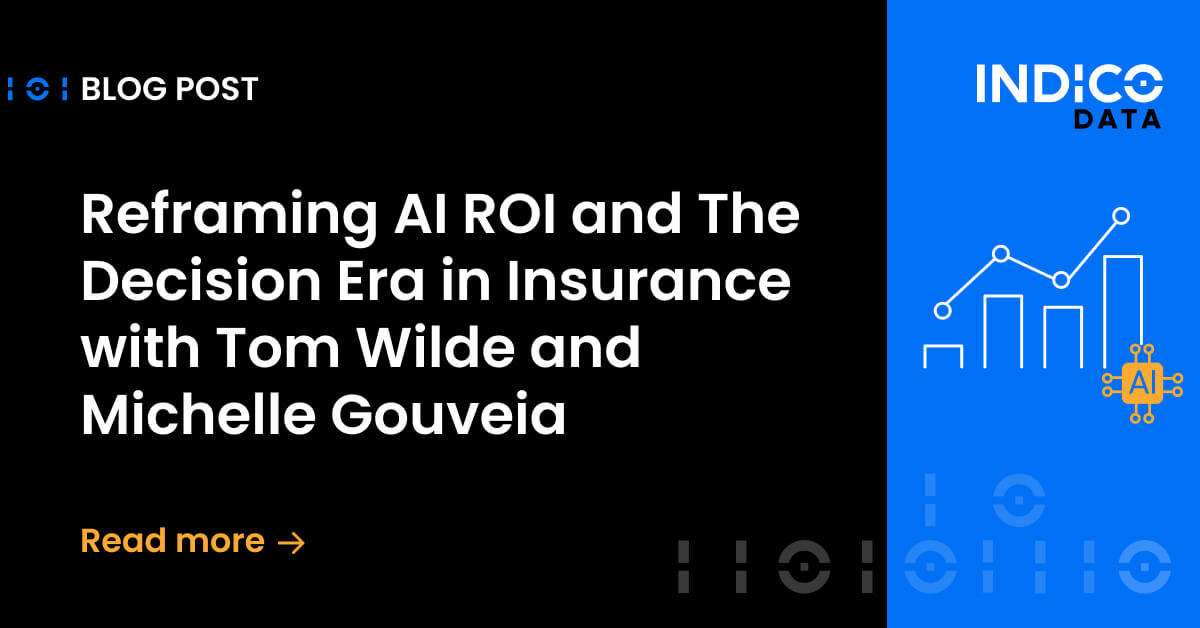The insurance industry has long been at the forefront of decision-making, but we now stand at the brink of a whole new era. Welcome to the Decision Era, where human expertise combines with advanced AI to reimagine how claims are managed, analyzed, and resolved.
Recently, Tom Wilde, CEO of Indico Data, and Maren Polakoski, Sr. Director of Claims Transformation at Markel, discussed the practical and transformational applications of AI in claims handling during the Insurtech Insights Fireside Chat titled “From Automation to Agency.” The insights shared in this conversation highlighted the shift in insurance claims workflows—from slow, manual processes to efficient, AI-powered decision-making that enhances outcomes for customers and insurers alike.
This blog explores key takeaways from their discussion, focusing on how automation and AI can redefine claims management while addressing change management, organizational buy-in, and customer-centric innovation.
The decision era: Elevating claims management
“The insurance industry is inherently a decision-based business,” explains Tom Wilde. “Should this risk be underwritten? Is this claim valid? That’s where the Decision Era takes us—with unrivaled access to data, scalable computation, and AI tools that enhance those decisions.”
While claims organizations have existed for decades, the challenges they face today are new. According to Maren, claims transformation is being driven by an overwhelming influx of data. “Our claims handlers spend too much time processing data instead of focusing on specialized knowledge and relationship-building,” says Maren.
Claims management is fundamentally about people. By leveraging AI to eliminate repetitive administrative chores, insurers allow examiners to focus on building human connections with claimants and handling cases with empathy and precision, especially when claimants have suffered a loss.
Change management in claims transformation
Organizational change doesn’t come easily. Many claims staff have been performing tasks the same way for decades, so introducing AI and automation requires strategic change management.
Tom highlighted the concept of the S-curve to illustrate the emotional trajectory of transformation. To achieve successful adoption, businesses must work through the “valley of frustration” before reaping the rewards on the other side.
Maren shared her own strategy for managing this change effectively:
- A digital adoption platform to provide self-help tools and resources for employees.
- A command center strategy to ensure real-time problem-solving during implementation.
- Change ambassadors to gain support from within the organization and foster peer-to-peer advocacy.
- User engagement through demos, prototypes, feedback loops, and continuous communication.
“Technology can only succeed if it makes sense to the people using it,” says Maren. Leadership buy-in is important, but empowering frontline claims staff and earning their trust through engagement is critical for long-term success.
AI in action for claims transformation
Implementing AI in claims requires a roadmap. According to Maren, the process begins with identifying the simplest problems to solve.
Early wins with low-hanging fruit
The First Notice of Loss (FNOL) process is often riddled with inefficiencies. A recent initiative integrated email-based FNOL submissions directly into the claims system using AI. This simple improvement significantly reduced cycle times—from days to mere minutes.
From there, organizations can tackle foundational areas like document ingestion and data extraction. For example:
- Automatically extracting key details like policy numbers and dates from unstructured data.
- Using AI-driven tools to streamline administrative tasks like assigning claims to the appropriate examiner.
These small victories create momentum and build trust in AI systems, paving the way for tackling more complex judgment-based aspects of claims handling in the future.
Transforming the customer experience
“An insurance claim is the product,” Maren emphasized. “It’s the moment when the customer expects us to deliver on our promise.”
AI doesn’t just improve operational efficiency; it also enhances the customer experience by reducing delays, errors, and redundancies. For example:
- Faster payment processes ensure that customers receive settlements within hours rather than weeks.
- Streamlined workflows allow examiners to resolve claims quickly without overwhelming customers with excessive data requests.
Ultimately, insurers build loyalty when claims are handled with care, respect, and efficiency. This is where AI can help balance automation with personalized service to meet customers’ needs during difficult moments.
Addressing fraud and regulatory challenges
The rise of AI adoption also coincides with increasing sophistication in fraudulent claims. Combating this requires insurers to integrate AI for fraud detection and prevention, identifying patterns and anomalies in data sets that signal potential red flags.
However, with great power comes great responsibility. Regulators are asking how insurers ensure fairness, accuracy, and compliance when using AI-driven tools. Both Tom and Maren stress the importance of keeping humans in the loop for oversight and accountability.
“AI should be thought of as your newest hire,” Maren explains. “You need to onboard it, train it, monitor it, and continuously test its outcomes. This ensures that AI evolves with your business needs while remaining compliant and trustworthy.”
The future of claims transformation
Looking ahead, both Tom and Maren predict that AI will drive more administrative tasks out of claims handlers’ day-to-day work and empower them to focus on higher-value activities.
“We’re going to see the industry experimenting with low-touch claims handling,” Maren says. “By extracting data and presenting it to examiners in actionable ways, AI will enable quicker decisions, better outcomes, and enhanced customer satisfaction.”
The rate of adoption will depend on how quickly organizations can build the trust and expertise necessary to implement AI responsibly. “Claims professionals are tough customers,” Maren admits. “They’re risk-averse by nature, and for good reason. But with deliberate steps, feedback loops, and an iterative approach, we can inspire confidence in this technology.”
Optimize your claims transformation with Indico Data
The Decision Era offers enormous potential for transforming claims into opportunities for better decision-making, improved efficiency, and stronger customer relationships. At Indico Data, we’re proud to partner with insurers to make this vision a reality.
Curious about how AI fits into your claims transformation strategy? Contact our team to explore how our solutions can empower your organization.


